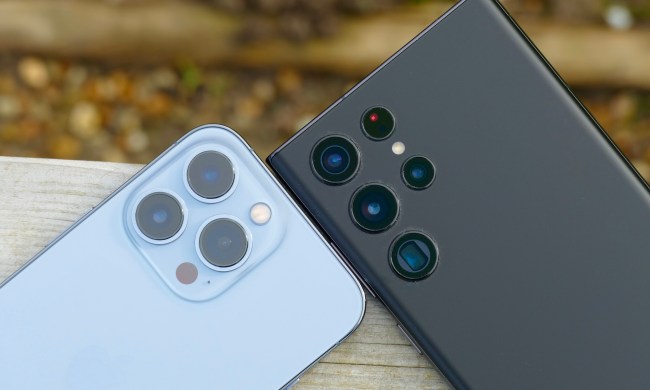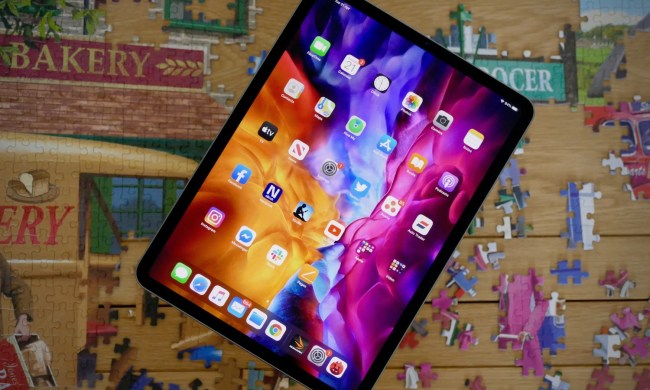
Though cell phone diehards have been flocking to Barcelona for MWC since 2006, the show has only gained steam with the wildfire adoption of smartphones across the world and the rising popularity of Android. This year, it shattered attendance records by reeling in 67,000 people. Next year, organizers have already planned to relocate it to a bigger convention center in anticipation of an even greater attendance.
Besides the fact that Barcelona substitutes sunlight and fountains for neon and casinos, Mobile World Congress thrives because it lives up to its name. It gives mobile products a chance to shine on their own, without the overwhelming clutter of a show like CES. Yet even with this narrowed field of gadgets, innovations, and announcements, there were plenty of stand outs. Some, we would argue, even outshine the best of CES 2012. If you’re looking to catch it all without sifting through six days of coverage, we’ve rounded up the top 10 MWC 2012 highlights right here.
 Nokia 808 PureView
Nokia 808 PureView
In case you haven’t heard, Nokia has unleashed a smartphone with a 41-megapixel camera sensor.
Yes, 41 megapixels is excessive. Yes, the front of this phone bulges out like John Goodman in lederhosen. Yes, it runs Symbian, the mobile operating systems Nokia keeps pledging to kill. But no, it’s not a gimmick.
By coupling an enormous sensor with sophisticated software that distills the raw resolution into something more usable, Nokia might actually have a shot at producing the best smartphone camera on the market, and may even outdo many point-and-shoots along the way. We’re not ready to call it a victory just yet, but would like to give the Finns (and Brits) at Nokia a much-deserved pat on the back for the innovation, especially after ribbing them over Symbian for all these years. (But seriously guys, put it on Windows Phone 7.)
 HTC One X
HTC One X
HTC has always had a strong showing at MWC, so it should come as little surprise that its flagship this year was one of the strong points of the show. If we could take home any phone, this would likely be it.
The uberfast and power-efficient Tegra 3 processor inside makes a good start to any class-leading smartphone, but the real appeal of the HTC One X lies in the details. A built-in driving mode allows it to play music, provide turn-by-turn directions, and even read texts while you drive. A dedicated imaging processor provides lightning-fast shutter speeds, burst mode, and even the ability to snap photos as you shoot video. Its 4.7-inch, 720p screen looks gorgeous. Oh, and it’s just 7.9 mm thin. When do we get our review unit again?
 Sony Xperia P WhiteMagic
Sony Xperia P WhiteMagic
Let’s not beat around the bush: Sony’s Xperia P looks like a pretty ordinary Android phone, but we’re really all about the screen. Sony’s WhiteMagic technology adds a white subpixel which, through some technological tomfoolery, actually makes it one of the brightest screens out there, and exceptionally resistant to the sun. No really, we actually tested it and it works pretty damn well. Those of us in Digital Trends’ Portland offices may only appreciate this feature once or twice a year, but for people in sunnier locales, this might be one of the most useful smartphone features to come out in recent years. Have you ever tried to use a smartphone screen in southern California? Those poor people have to step into their Lamborghinis just to read text messages.
 Windows 8 Consumer Preview
Windows 8 Consumer Preview
Chalk this one up as one of the least surprising but most pertinent announcements of the show. Microsoft has finally unveiled the consumer preview version of Windows 8, which will meld a touch-friendly tablet interface known as Metro with the traditional Windows desktop. It stills seems like there are plenty of kinks to work out (see our hands-on assessment here) but there’s no denying that a radical shift in Windows will reshape the future of computing as we know it.
 Samsung Galaxy Beam
Samsung Galaxy Beam
Samsung’s second Galaxy Beam – the first was very similar – is a smartphone with a built-in DLP projector. We don’t really present things on walls enough to actually need or want a projector phone, but the sheer novelty of this thing deserves a mention. You can show movies, PowerPoint presentations, or even project a live view from its built-in camera. For three hours no less! And unlike the original, it’s thin enough to use as a real phone.
 LG Optimus Vu
LG Optimus Vu
Truthfully, we weren’t overly fond of LG’s supersized 5-inch Optimus Vu, but it remains notable if only to prove that “fablets” – oversized phones or mini tablets – are becoming a legitimate product category outside Samsung’s experimental Galaxy Note. The 4:3 aspect ratio is also a unique twist, and you can’t deny how luxuriously thin this thing is at 8.5 mm thick: a dimension that only seems exaggerated by its otherwise sprawling footprint.
 Asus PadFone
Asus PadFone
It’s a phone inside a tablet. The 4.3-inch PadFone locks into a hatch in the back of a special tablet dock, which in turn snaps into another dock that turns the entire contraption into something resembling a laptop. In practical terms, this means that the same apps and documents you keep on your phone now carry across to your tablet and laptop without any need for the cloud or syncing, you just need one 3G connection, and battery life gets better with every accessory you add. Asus even built a stylus that works as a Bluetooth headset, so you can pick up the phone without yanking it out of the back of the tablet when someone calls. We’ve known this thing was coming for months now, but now it’s real, official, and going on sale this year.
 Windows 7 Tango
Windows 7 Tango
Windows Phone Tango will be less of a new release and more of a greased up version of the last release: Microsoft engineers primarily spent time optimizing code so it could run on less expensive hardware. If you already live life on the bleeding edge of technology, that’s boring news, but the two new budget handsets that ran it at MWC (the ZTE Orbit and Nokia Lumia 610) felt surprisingly snappy even with their relatively lame specs. Impressive. And if you’re already running better hardware, Tango should speed that up, too, so there’s still something to look forward to.
 Google’s Android booth
Google’s Android booth
With Apple nowhere to be found at an event like Mobile World Congress, Google suddenly becomes big man on campus. And for once, the typically low-fanfare tech giant acted the part with a booth that was one part exhibition and one part fanboy amusement park. You could grab a literal ice cream sandwich, try to snatch Android plush dolls in a crane machine, watch a robot create a custom-jeweled back for your Galaxy Nexus, or hop into a two-story slide that twisted around an equally tall Android. See Google? You can pry open that wallet to reward the faithful now and then.
 Eric Schmidt’s keynote
Eric Schmidt’s keynote
Most expected Google chairman Eric Schmidt to rattle on endlessly about the future of Android at his MWC keynote, but the plucky (and occasionally caustic) ex-CEO actually went a lot deeper. His lecture on the capability of mobile technology to change the world as we know it implored listeners to look beyond the convenience it has brought to first-world countries to see how it could radically affect impoverished nations. While Schmidt cautioned that technology had the potential to only widen the gap between rich and poor, he believes that technology like mesh networking could also help entrepreneurial people in less fortunate areas reach beyond their borders and educate themselves.
Besides the thought-provoking keynote address, we particularly enjoyed the Q&A, in which Eric Schmidt inadvertently proved that he may be the closest man now living to a human Wikipedia. The path of the fiber-optic cable that connects Nigeria to Portugal? Yea, he knows all about that off the top of his head. Somebody get this man on Jeopardy.














